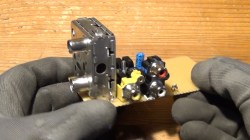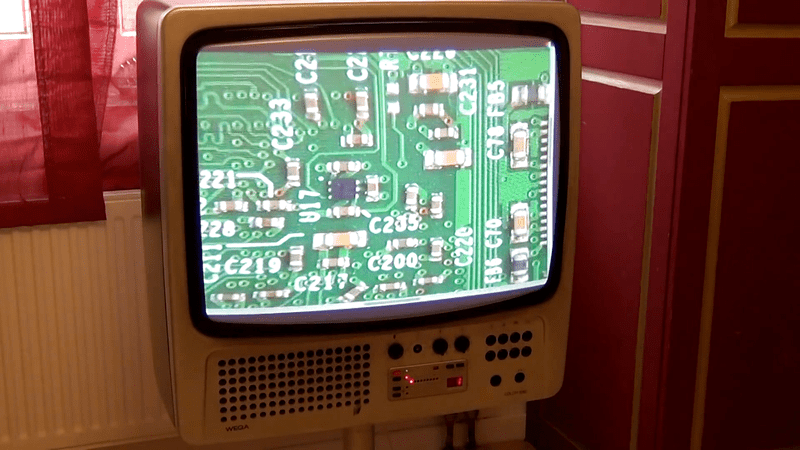One of our favorite hacker-scavengers on YouTube, [The Post-Apocalyptic Inventor], has been connecting his Raspberry Pi up to nearly every display that he’s got in his well-stocked junk pile. (Video embedded below.)
Modern monitors with an HDMI input connect right up to the Pi. Before HDMI came VGA, but the Pi doesn’t do that natively. One solution is to use a composite-to-VGA converter and pull the composite signal out of the audio jack. Lacking the right 4-pole audio cable, [TPAI] soldered some RCA plugs directly onto the Pi, and plugged that into the converter. On a yet-older monitor, he faced a SCART adapter. If you’re European, you’ll know these — it’s just composite video with a different connector. Good thing he had a composite video signal already on hand.
 The pièce de resistance, though, was attaching the Pi to his 1980 Vega TV set. It only had an antenna-in connector, so he needed an RF modulator. With a (presumably) infinite supply of junk VCRs on hand, he pulled an upconverter out of the pile, and got the Pi working with the snazzy retro TV.
The pièce de resistance, though, was attaching the Pi to his 1980 Vega TV set. It only had an antenna-in connector, so he needed an RF modulator. With a (presumably) infinite supply of junk VCRs on hand, he pulled an upconverter out of the pile, and got the Pi working with the snazzy retro TV.
If you’re interested in running an old TV as a display, just because it looks cool, this video is a must-watch. As usual, [The Post-Apocalyptic Inventor] turns his pile of junk into something useful in the end, and you’ll probably learn something along the way. And that’s why he’s one of our favorite frackers.
















Scart: The worst connector ever. Detaches itself over time, unable to connect without seeing it (99,9% is on the backside of devices) and flimsy metal strips for contact, easy to bent whil trying to connect the damn thing. But it could handle component video, stereo sound and a control signal.
It was as easy as a PS/2 connector to plug in. And that thick cable was a nightmare.
But it still was a great interface.
It’s French, what were you expecting?
Lies there was never a white flag of their nation on it.
They made really great tanks though. 1 gear forward. 5 in reverse, HAHA!
Oh heck that brings back memories of when my folks got a wall mounted flat screen TV.
To keep the TV slim, the “designers” thought it’d be an excellent idea to put the SCART sockets facing the ground,so the damn cables would simply fall out under their own weight. Hot snot was the only way to keep them in.
It would have been a lot easier to connect those if the receptable on the TVs were a bit recessed instead of flush with the surrounding surface.
you plug it once and forget about it, its a fair price to pay for >20 years of razor sharp RGB master race
btw my first PC monitor was a regular 21′ TV with Euro connector, special cable (combined V and H sync) and DOS TSR to reprogram CRTC. Perfect 13h, readable text modes. Finished Doom 1/2 and Colonization on 386DX40 connected to that TV. Worked great for almost a year until I finally got a proper 14′ months salary down the drain display.
similar to this http://www.nexusuk.org/projects/vga2scart/ except mine used NAND gate
you can use Powerstrip on older windows to reach 15KHz, no idea where to find old DOS TSRs nowadays, in linux it used to be as simple as one line in xconfig.
Actually SCART was the best inputca consumer had until VGA or component. This article incorrectly suggests SCART was just a composite output, but this isn’t the case. It can transmit composite and s-video signals just fine, but the main benefit was RGB which absolutely crushes composite and s-video into dust. Yeah it’s a bit janky in the unit, but not much moreso than HDMI, but it was a worthy tradeoff for higher quality picture quality.
” it’s just composite video with a different connector.”
It’s also s-video and RGB depending on which pins you use.
Yeah – that annoyed me too. SCART was a lousy connector but a great solution for the 80s. It allowed unidirectional RGB – so you could have really clear pictures from your 8 or 16 bit home computer without nasty composite chroma footprints. It also allowed great quality from DVD players and the component analogue satellite transmissions we had (D/D2-MAC) which were better quality than current SD digital stuff…
AIUI SCART included RGB and an RGB/Composite ‘fast blanking’ signal that allowed you to composite the RGB and composite feeds carried on a single SCART connector within the TV. This was to allow you to have an external teletext decoder – in the days when teletext (Ceefax and Oracle in the UK) was new, and not standard in all TVs.
… and stereo audio, and and. SCART has like 20 signals on it, right? It’s mental.
Reminds me my first computer. I made a video card with a 6845 chip, but didn’t have any monitor… only a B&W TV !
I used a UHF TV tuner salvaged from a scrapped TV as a UHF source modulated by the composite video from the card. I presumed that low power and direct coupling ensured no parasite broadcast :-)
Lack of money was (and is allways) a good motivation for hacking !
Same here :-)
Been there, done that.
http://i.imgur.com/OYsg7.jpg
http://i.imgur.com/UsgIp.jpg
The main difference is that I built the modulator from an electronics kit, because I needed to use a low VHF channel (Band I or for NTSC-land on channels 2-6) because in UHF there was interferecne from DB stations.
Nice but I’ed really like to see somebody hook up a Raspi to a really weird old standard like 405 or 819, now that would be a challenge. Also where do I get one of those Ultra High Frequency Tunas he was talking about. :)
Mechanical Television AKA The Televisor. I want to see that, and not just a script playing an audio file to drive one. I want to see the an actual framebuffer driver with X and a regular desktop on top of it.
I doubt it will have enough resolution to actually be usable but as long as it is good enough that we can recognise it is working I will be satisfied.
Though if you really want to mess with mechanical television, near IR for a scanned thermal camera would be a good target, because decent resolution sensors are still really spendy.
That would be cool, wonder if you could do it with the Raspberry Pi GertBoard VGA output solutions that use GPIO pins to expose digital video and a quick’n’dirty resistor ladder DAC to convert it to analogue? Don’t know if the Pi allows for custom timings (though it may be possible for a firmware dev to add them if not?).
One cool hack that does exist already is a software only method of injecting teletext data into the VBI of the composite output.
it actually does allow custom timings, and some people use it like that
https://www.raspberrypi.org/forums/viewtopic.php?f=29&t=24679&start=118
Umm… Composite out from a Pi is a regular feature. Composite to RF modulators used to be standard equipment in every living room, are still available new and used ones are a dime a dozen.
Here’s another way to hook up a TV with only an arial input. Instead of cracking open an old VCR crack open the TV!
Usually the tuner is just a little shielded bos much like the modulators he pulled from old VCRs. Often, rather than just a soldered wire they actually have a RCA jack with a little piece of coax taking the output from the tuner and sending it to some other part of the tv. Hmm… guess what that is… Composite!! If this is all you are going to use the TV for you can just unplug the tuner and plug a little RCA extension cord in it’s place and run it out one of the air vents in the back of the device or maybe drill a hole if necessary. If you still want to use the tuner (is there any analog OTA signal to receive anyway?) you can run a second wire with a male plug on one end to the tuner and put an A/V switch at the back.
This way you NEVER have to convert to RF and back, it’s the best possible picture, even better than what you might get form a more expensive modulator… Yay!!! And.. if you want to restore the TV back to original.. well.. if you found a place to run the cable that did not involve drilling it’s easy. Just unplug your cable and plug the tuner back in.
As a kid I did this in order to play video games on an old garage sale tv. It worked great!
One disclaimer… I have only ever done this with NTSC TVs. I would be surprised if PAL is any different but… what do I know about that?
This would be a suicide hack in most parts of the world. In 220V-countries, old TVs without AV connectors often have a hot chassis without any mains isolation, even transistorized ones. And don’t get fooled by the RCA jack on the tuner box, it might be the connection to the IF-strip.
yes about the hot chassis
yes about the IF jack but its still possible a TV might have IF demod inside tuner shield… and besides, what really DOES happen when you inject NTSC (without sound) into an IF input jack? maybe it really does work but emits illegal unintended interference (local IF osc)? but again, your going to have high-voltage DC+AC superimposed onto the input source’s chassis, the low-voltage isolation is not designed for one side to be at high voltage, not when the other side is maybe neutral of opposite polarity
Second disclamer: you might get an electric shock and die.
Always read the warning labels on electronic equipment…. so you can tell the paramedics what you did.
I have never seen an RCA plug on a tuner module, but I never opened a TV this old. Most tuners I saw exposed the 36MHz (or so) IF instead of the CVBS+Audio. Depending on the TV design you may need an isolation transformer as well, as some sets with only an antenna input use non-isolated supplies (the RF input is isolated instead).
There was a bit of a fad for modularity at one point, so manufacturers could offer a dozen models but only need one tuner.